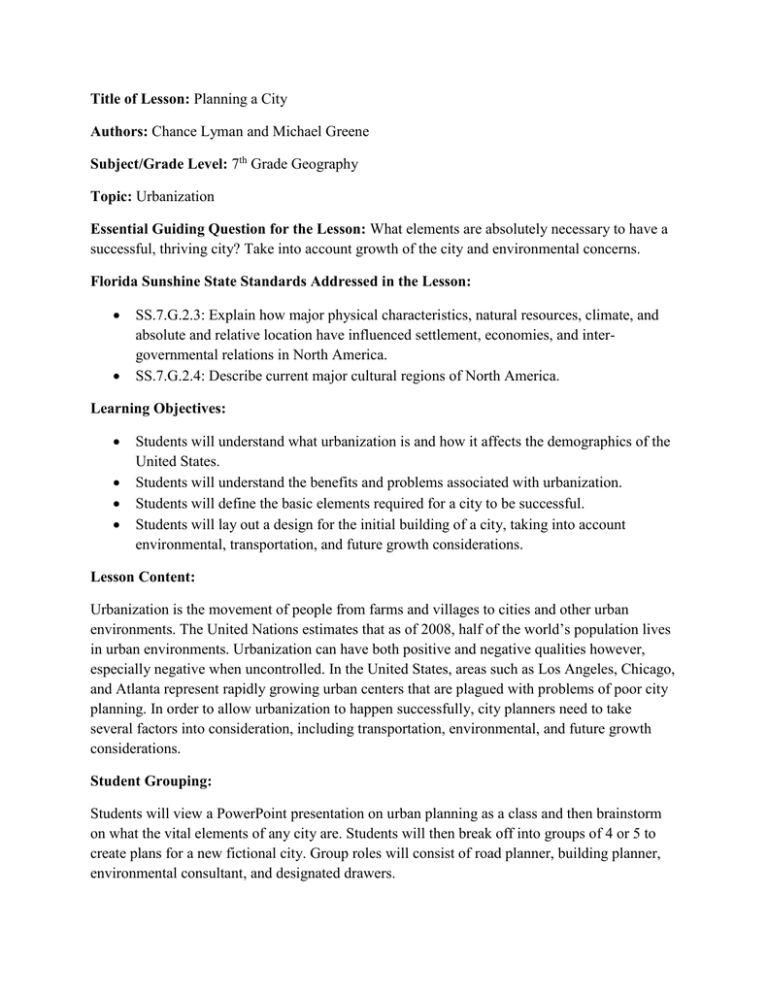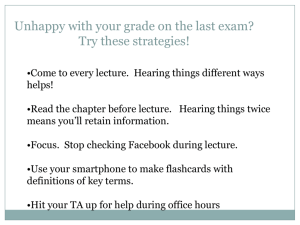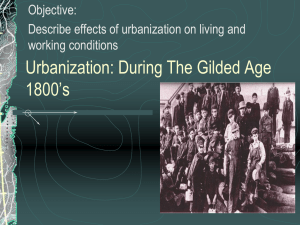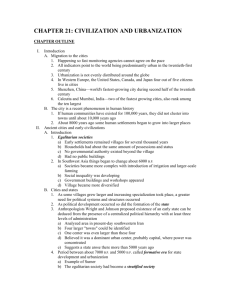Title of Lesson: Planning a City Authors: Chance Lyman and
advertisement

Title of Lesson: Planning a City Authors: Chance Lyman and Michael Greene Subject/Grade Level: 7th Grade Geography Topic: Urbanization Essential Guiding Question for the Lesson: What elements are absolutely necessary to have a successful, thriving city? Take into account growth of the city and environmental concerns. Florida Sunshine State Standards Addressed in the Lesson: SS.7.G.2.3: Explain how major physical characteristics, natural resources, climate, and absolute and relative location have influenced settlement, economies, and intergovernmental relations in North America. SS.7.G.2.4: Describe current major cultural regions of North America. Learning Objectives: Students will understand what urbanization is and how it affects the demographics of the United States. Students will understand the benefits and problems associated with urbanization. Students will define the basic elements required for a city to be successful. Students will lay out a design for the initial building of a city, taking into account environmental, transportation, and future growth considerations. Lesson Content: Urbanization is the movement of people from farms and villages to cities and other urban environments. The United Nations estimates that as of 2008, half of the world’s population lives in urban environments. Urbanization can have both positive and negative qualities however, especially negative when uncontrolled. In the United States, areas such as Los Angeles, Chicago, and Atlanta represent rapidly growing urban centers that are plagued with problems of poor city planning. In order to allow urbanization to happen successfully, city planners need to take several factors into consideration, including transportation, environmental, and future growth considerations. Student Grouping: Students will view a PowerPoint presentation on urban planning as a class and then brainstorm on what the vital elements of any city are. Students will then break off into groups of 4 or 5 to create plans for a new fictional city. Group roles will consist of road planner, building planner, environmental consultant, and designated drawers. These grouping methods will ensure that the class is on track in the beginning, by going over all the necessary elements of a city together. For the group activity, students are asked to get in groups of 4 or 5 because this simulates the actual process city planners go through when building a city. Like planners, students must work together to ensure that all the needs of the city are met and adequate plans are laid out to ensure the cities success. Methods: Lecture: The students will gain background knowledge of what urbanization is through a short, teacher led lecture. Brainstorming: As a class, students will come up with a list of necessary buildings required for a city to be successful. Cooperative Learning: Students will work in groups to create a plan for a fictional city. These methods will ensure that students are equipped with the tools and understanding they will need to complete the task of planning a city. Using the brainstorming method, students will work as a class to make sure they are all using the same list of important buildings when planning their cities. The cooperative learning activity will simulate the actual activity of planning a city and will allow students to take a much more realistic view towards urbanization. They will also work on their cooperative learning and social skills and come together to create a finished city. Opening Activity (5 minutes): Students will copy down the guiding question for the lesson. The instructor will ask the students what they already know about urbanization and address the various comments. Main Activities (40 minutes): The instructor will present a brief PowerPoint show, detailing what urbanization is, where it is found, what the pros and cons of it are, and why it is an important geographical principle. The lecture will also discuss the various environmental, transportation, and future growth concerns any city will have. Then the teacher will guide the class in a brainstorming activity where they must come up with a list of all the essential buildings a city must have. The students are expected to provide most of the buildings for this activity based on the environmental, transportation, and future growth concerns discussed in the lecture, but the teacher may need to add some such as utilities or other less obvious ones. The students will then break off into groups of four or five and, using the list of buildings and the information from the lecture, design a new, fictional city that will represent a well planned outcome of urbanization. The city must take environmental, transportation, and future growth concerns into consideration. It must also display a mastery of the content discussed in the lecture and it must include whatever the class decided as vital buildings. Students will create a quick, rough draft of the plans to be approved by the teacher before they begin work on a complete, finalized plan. Important Questions to Ask: o What buildings are the most important to a brand new city? o How will you ensure that members of a city can get safely and efficiently from place to place? o How will you feed, clothe, protect, and house the members of your city? o Where will the citizens of your city work, relax, and learn? o How will you protect the environment from potential pollution problems from your city? o How will you ensure that your city maintains efficiency, even as it rapidly grows? Closing Activity (5 minutes): Students will answer the guiding question from the lesson in a one paragraph response in their notebooks. Students will be given more time to complete their plans during the next class, and will be asked to make any final improvements as homework. Materials: Projector, computer, and PowerPoint on urbanization Smart board, chalkboard, or dry erase board Pencils, graphing paper, and rulers These materials will ensure that students absorb the tools and understanding they will need to complete their city project. The smart board, chalkboard, or dry erase board will provide a medium for which to engage in the brainstorming activity. The pencils, graphing paper, and rulers are materials needed so students can create and present accurate city plans, in much the same way that actual city planners work. Evaluation: Students will be evaluated on what they learned from this lesson by their responses to the guiding question of the lesson, as well as their city plans. As part of the evaluation of the city plans, students will present their plans to the class, which will make comments as to what they liked or did not like about the plans and then vote to decide the best plan. Students’ plans will be evaluated by the teacher to see if they accurately take into consideration environmental, transportation, and future growth considerations. The plans will also need to contain whatever buildings the class decided on as most important.






